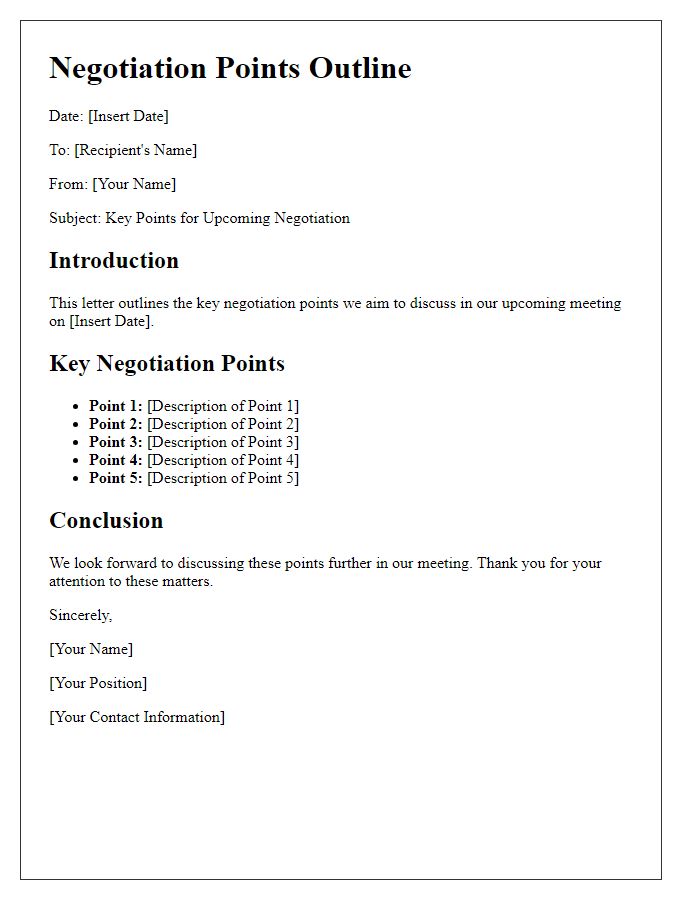Are you gearing up for a contract negotiation and feeling a bit overwhelmed? You're not alone; many people find this process daunting, but with the right strategy, you can turn it into a successful collaboration. In this article, we'll break down a clear letter template designed to guide you through the negotiation process, helping ensure that your interests are well represented. So, if you're ready to master your contract negotiations, read on for some invaluable tips and insights!

Contact Information and Date
Effective contract negotiation relies heavily on clear communication and organization of pertinent information. Contact information should include full names, job titles, phone numbers, and email addresses of all key stakeholders involved in the negotiation process to ensure seamless communication. Include the date prominently at the top of the document for chronological clarity, as both parties often refer back to original negotiations in future discussions. This foundational information sets the stage for a productive dialogue and establishes accountability among participants in reaching mutually beneficial agreements.
Salutation and Introduction
In contract negotiation strategy, effective communication is crucial. Begin with a respectful salutation, addressing the relevant parties by name, such as "Dear [Name]" or "To the [Title/Team]". This sets a professional tone. Follow with a concise introduction, outlining the purpose of the negotiation. For instance, mention the specific contract, such as the "Service Agreement for [Project Name]" dated "January 15, 2023". Express appreciation for the opportunity to discuss terms, emphasizing the goal of achieving a mutually beneficial agreement. Highlight key areas for negotiation, including financial terms, deliverables, and timelines, ensuring clarity for all involved parties.
Objectives and Key Terms
Establishing clear objectives in contract negotiation is crucial for successful outcomes. Key terms such as payment schedules, performance standards, and timelines must be defined to avoid misunderstandings. Each party should outline their goals, such as ensuring compliance with industry regulations or achieving cost savings, which can be quantified (percentage reduction in costs or specific compliance benchmarks). In addition, important entities like governing law (specific jurisdiction or legal framework) and dispute resolution methods (mediation or arbitration processes) should be noted to streamline potential conflicts. Furthermore, identifying critical milestones or deliverables within the negotiation can help maintain focus and accountability, ensuring all parties have a shared understanding of expectations.
Mutual Benefits and Proposed Adjustments
Effective contract negotiations require a focus on mutual benefits to ensure both parties achieve satisfactory outcomes. For instance, when discussing pricing adjustments, consider proposing a tiered pricing model that encourages bulk purchases, leading to cost savings for the buyer while securing higher volume sales for the seller. In the realm of service agreements, clarifying key performance indicators (KPIs) can foster transparency and accountability, enhancing the overall service delivery on both sides. Additionally, suggesting flexible payment terms might ease cash flow concerns for clients, while ensuring steady revenue for suppliers. Strategic adjustments like these contribute to a more collaborative atmosphere, paving the way for successful long-term partnerships.
Closing Remarks and Next Steps
During contract negotiations, the closing remarks signify a pivotal moment where mutual understanding reached can lead to formal agreement. Clarity on key terms such as deliverables, timelines, and payment structures is essential. Emphasis on the agreed-upon conditions can solidify the collaborative spirit fostered during discussions. Next steps involve detailing actionable items like finalizing contractual language, scheduling a signing date, and distributing the relevant documentation to involved parties. Timelines for these actions should be established, ensuring all stakeholders, including legal teams and executives, are aligned for a smooth transition into the execution phase.













Comments